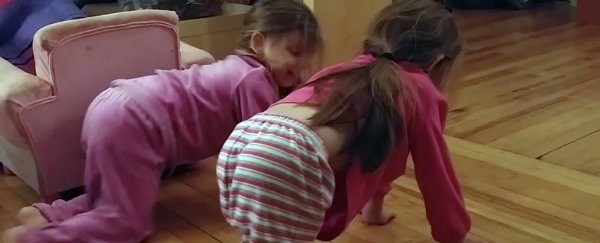Spinal muscular atrophy (SMA) is a very rare genetic disorder that often leads to early death in young patients, but a new experimental drug has produced some incredible results in a recent trial - it's even enabled several children with the disease to walk again.
The effects of the drug nusinersen have been so remarkable, a recent trial of the drug was actually cut short in August. Why? because it was unfair and even unethical to keep some of the children on a placebo when nusinersen was working so well on the treatment group.
You can see the positive impact yourself in the video below of one of the patients. After years of being unable to even crawl, children on the treatment have been gradually regaining strength and starting to move again - even walking with assistance.
Spinal muscular atrophy can vary greatly in severity from patient to patient, but it basically causes the nerve cells to stop working and significantly weakens the muscles. Within a year or two, many affected children can't sit up, move their limbs, or swallow unaided.
"To see children who would have been dead sitting and standing is something I never thought I would see," researcher Francesco Muntoni from University College London in the UK told Michael Le Page at New Scientist.
Muntoni and his colleagues are one of several teams across the world working on 'antisense treatments' like nusinersen - drugs that aim to switch off the expression of a particular gene.
In these therapies, a specially engineered piece of DNA is used to target certain RNAs (protein recipes) and alter the proteins produced.

The major problem is getting these DNA fragments to last inside the body and actually enter the cells, but nusinersen appears to be at the forefront of attempts to find a solution.
While we don't yet have proof that nusinersen is the answer to spinal muscular atrophy - the final results of the latest trials are yet to be published - there is evidence in studies with mice that once the drug is injected, it can spread throughout the brain and the spinal cord.
Early positive results in the clinical trial so far suggest that the same effect is taking place in humans, but we won't know for sure until the researchers publish their findings.
If the final results of the trial live up to their promise, specially engineered antisense drugs like nusinersen, that are designed to silence specific genetic defects, could offer hope for those with similar conditions, such as Huntington's disease, motor neurone disease, and Alzheimer's.
Antisense drug trials for Huntington's are already underway, and the scientists behind them have said they think these approaches could one day lead to a cure. Tackling Huntington's is easier in some respects than tackling Alzheimer's, because there's a specific and common gene mutation that can be targeted.
But there's still a long way to go with any of these antisense therapies. In their current form, the treatments must be repeated every few months, and injected directly into the spinal canal in a process called lumbar puncture (aka spinal tap).
From there, the medication flows through the brain and spine with cerebrospinal fluid – but side effects from the treatment, such as headaches and back pain, can also appear.
With time, though, it's hoped that the drugs can be refined to minimise these issues. The early results of have been promising enough for pharmaceutical company Biogen to press ahead with getting nusinersen approved and regulated.
"We are grateful to the families participating in the clinical trials, who continue to inspire us," said Biogen's chief medical officer in an August press release.
The research isn't over yet, but thankfully it looks like we could be getting closer to a solution for this terrible disorder.
Watch this space.
